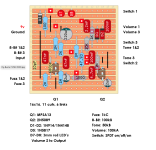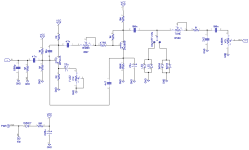Apologies - I'm in "boot camp" mode and still learning schematics. And everything else...
This may help: how can I determine which resistors in a given schematic are biasing each transistor?
I've been working from Vero diagrams too, which I'm sure REALLY spell it out. Still, I'm not sure how to determine this.
For instance, the (awesome) Fig Buster. I built one based on @music6000 's Vero diagram, but I think I'd like to add a transistor bias/gate knob to cut down on noise when Fuzz and 8-Bit are cranked. What am I looking for here?

This may help: how can I determine which resistors in a given schematic are biasing each transistor?
I've been working from Vero diagrams too, which I'm sure REALLY spell it out. Still, I'm not sure how to determine this.
For instance, the (awesome) Fig Buster. I built one based on @music6000 's Vero diagram, but I think I'd like to add a transistor bias/gate knob to cut down on noise when Fuzz and 8-Bit are cranked. What am I looking for here?



